Hey, welcome to the first of the two Sex Number entries of the Mega Archive! (I'll probably be deep into the late '90s when Part 69 comes along. Deep into something, anyway.) This entry covers the majority of the games that debuted on the Sega Mega Drive/Genesis in the west across March of 1993, with next week's rounding up those that first released in Japan during that same month (and our first look at April also). We'll cover it more when we get back around to Mega Archive CD but we're right on the cusp of the European launch of the Mega CD, which debuted in early April over here. After that, Sega's hardware division will be gearing up for the 32X and Saturn (released a day apart, in case you forgot how that all went down) but we won't have to worry ourselves about any of that mess until the end of 1994.
Sad to say that this assortment of Mega Drive games isn't all that titillating but it does present that rare and precious instance of a western studio-focused Mega Archive that isn't completely dominated by sports games—there's only two, which is letting us off easy—and is instead heavy on the Amiga/Atari ST ports. I've a huge fondness for those weird home computer games so beloved by Europeans, so this should be a fun blast from the past for me and probably very few others. Between all the UK and US developers we also have Konami and SNK sightings, both of whom making the smart marketing decision of releasing their games overseas first given the system's greater international popularity.
Talking of popular, here's the big ol' board of past Mega Archive entries to peruse. Feels like this table gets bigger every time, no? So strange.
| Part I: 001-020 (Oct '88 - Dec '89) | Part XI: 161-175 (Jul '91 - Aug '91) | Part XXI: 311-320 (Sep '92 - Oct '92) |
| Part II: 021-035 (Dec '89 - Mar '90) | Part XII: 176-190 (Aug '91 - Sep '91) | Part XXII: 321-330 (Oct '92) |
| Part III: 036-050 (Apr '90 - Jul '90) | Part XIII: 191-205 (Oct '91 - Nov '91) | Part XXIII: 331-340 (Oct '92 - Nov '92) |
| Part IV: 051-065 (Aug '90 - Oct '90) | Part XIV: 206-220 (Nov '91) | Part XXIV: 341-350 (Nov '92 - Dec '92) |
| Part V: 066-080 (Oct '90 - Dec '90) | Part XV: 221-240 (Dec '91) | Part XXV: 351-360 (Dec '92) |
| Part VI: 081-098 (Dec '90) | Part XVI: 241-255 (Jan '92 - Feb '92) | Part XXVI: 361-370 (Dec '92) |
| Part VII: 099-115 (Jan '91 - Mar '91) | Part XVII: 256-270 (Mar '92 - Apr '92) | Part XXVII: 371-381 (Dec '92) |
| Part VIII: 116-130 (Mar '91 - Apr '91) | Part XVIII: 271-285 (Apr '92 - Jun '92) | Part XXVIII: 382-390 (Jan '93 - Feb '93) |
| Part IX: 131-145 (May '91 - Jun '91) | Part XIX: 286-300 (Jul '92 - Aug '92) | Part XXIX: 391-400 (Feb '93) |
| Part X: 146-160 (Jun '91 - Jul '91) | Part XX: 301-310 (Aug '92 - Sep '92) | Part XXX: 401-410 (Mar '93) |
Part XXX: 401-410 (March '93)
401: David Crane's Amazing Tennis
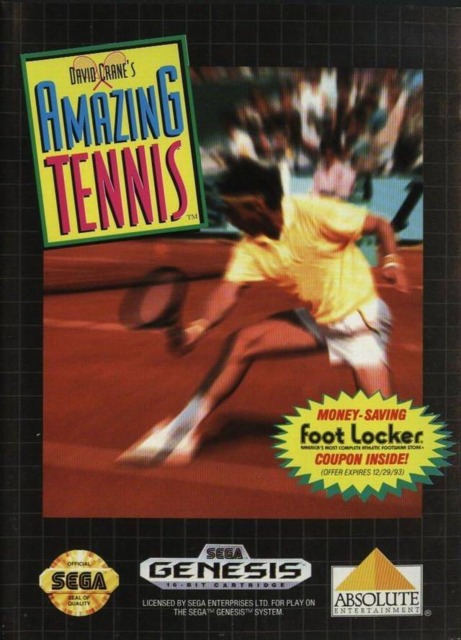
- Developer: FarSight Technologies
- Publisher: Absolute Entertainment
- JP Release: N/A
- NA Release: March 1993
- EU Release: N/A
- Franchise: N/A
- Genre: Tennis
- Theme: Tennis
- Premise: Tennis, but it's amazing.
- Availability: A contemporary SNES release but that's about it.
- Preservation: David Crane, the visionary behind Pitfall! and A Boy and His Blob among many others, was not one to stick to any single subject for long. While he always had bold ideas for genres old and new they didn't always pan out the way the gaming public might've preferred, and Amazing Tennis is perhaps one of those cases. The issue here is that, in an effort to make a more realistic tennis game, the vertical distance of the camera was greatly reduced so you were essentially seeing the game at eye level. This meant it was as hard to predict where a serve might go as it is in real life, given the net would always be obstructing your view of the opposing side of the court from your position on the serving line. Playing two-player meant some unlucky sucker always had to play as the guy in the far distance, which put them at a distinct disadvantage. Still, mechanically it was one of the more in-depth tennis games available in that era. We last met FarSight with Action 52 so they've definitely come up in the world, but sadly after this they would become one of Sega's go-tos for their homegrown sports games from here until the console was retired (their NFL '98 was one of the last games released on Genesis). Awesome. Even more sports games to look forward to.
- Wiki Notes: As always, I'm relieved to encounter a double-dip from my SNES wiki editing days. Just needed MD-specific releases and screenshots.
402: Jack Nicklaus' Power Challenge Golf
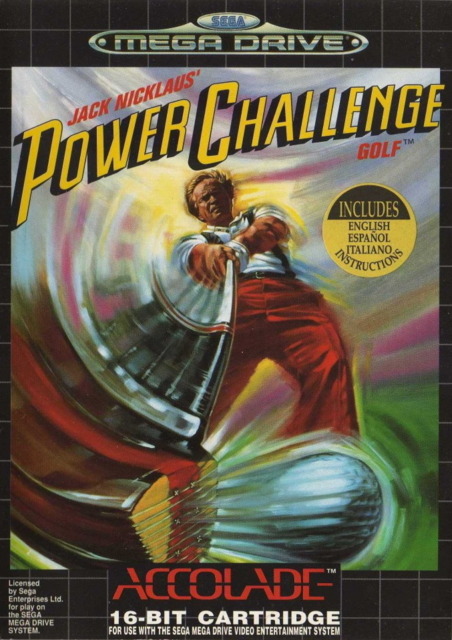
- Developer: Microsmiths
- Publisher: Accolade
- JP Release: N/A
- NA Release: March 1993
- EU Release: June 1993
- Franchise: Jack Nicklaus Golf
- Genre: Golf
- Theme: Golf
- Premise: Get ready to hit the links with America's favorite golfer (citation needed) as Mr. Nicklaus takes you on a tour of some of his favorite holes. Golf holes. That's obviously what I meant.
- Availability: Nah.
- Preservation: The Golden Bear has once again lumbered out from his cave to grace us with another interminably dull simulation golf game. Accolade published the cumbersomely-titled Jack Nicklaus' Greatest 18 Holes of Major Championship Golf on various home computers back in the late '80s and continued to use the license with iterative sequels for a while thereafter. This is actually based on the third game, Jack Nicklaus Golf & Course Design: Signature Edition, which like its predecessor included tools to make player-created golf courses as its hook. Naturally, since that tech wouldn't really jibe well with the limitations of the Genesis console, they scooped all that out leaving only the standard single-player content behind though makes up for it by expanding said content, throwing in New Jersey's Baltusrol course since it was the setting for the US Open that year. As a simulation-heavy golf game we're once again looking at a game that rapidly aged into obsolescence within months, so its preservation potential is questionable. This will be the last we see of Mr. Nicklaus for this feature: future sequels in this series remained PC exclusive (we'll have plenty more MD Accolade games though, don't you worry).
- Wiki Notes: It's technically a new game rather than a port given the amount of new additions and vital changes to the base game which necessitates a separate page on our wiki. That meant creating a page from scratch. Not as much work as it sounds though.
403: James Bond 007: The Duel
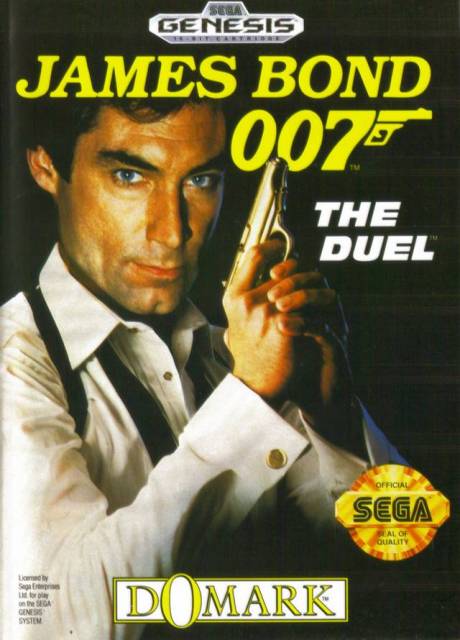
- Developer: Domark
- Publisher: Domark (EU/NA) / Tengen (JP)
- JP Release: 1993-05-14
- NA Release: March 1993
- EU Release: 1993-04-07
- Franchise: James Bond 007
- Genre: Action
- Theme: Espionage
- Premise: Bond, James Bond, is back to disable bombs, rescue damsels, and save the world from powerful villains in this original adventure that still kinda resembles all his other ones.
- Availability: Nothing so far. Though with GoldenEye 007 recently getting a remaster...
- Preservation: While GoldenEye 007 was really the first game to do right by the James Bond book and movie franchise that isn't to say it didn't see a lot of movie tie-ins prior to that. The Duel is one of the rare cases of a Bond game with an original story, taking the current Bond (which at the time was Timothy Dalton) and putting him in a new adventure albeit with a few familiar villains. It's one of those side-scrolling shooter games in the vein of a Shinobi or Rolling Thunder where you run around levels trying to find your targets while quickly dispatching enemies before they can shoot you, and more than a bit clunky in the manner Amiga action games tended to be. That said, the game is a Sega console original: Domark only dropped versions on Master System, Mega Drive, and Game Gear with some significant deviations between the 8-bit and 16-bit versions. On that note this is also our first formal introduction to Domark, a major UK publisher who has been the European distributor for many of the Tengen games we've covered so far; this is the first Mega Drive game to come from them directly. Named for their co-founders, Dominic Wheatley and Mark Strachan, Domark was much like other Europe-based game companies at the time in that they were primarily focused on the Amiga and Atari ST and the Mega Drive's familiar system architecture (and its success) made it an obvious territory to broaden into. They'll show up a handful more times both here and on Mega Archive CD.
- Wiki Notes: Minor edits in all areas, plus a header image. Grateful someone made a decent stab at this page back when the site was new. Guessing they were a Bond fan more than they were a Domark fan.
404: King of the Monsters
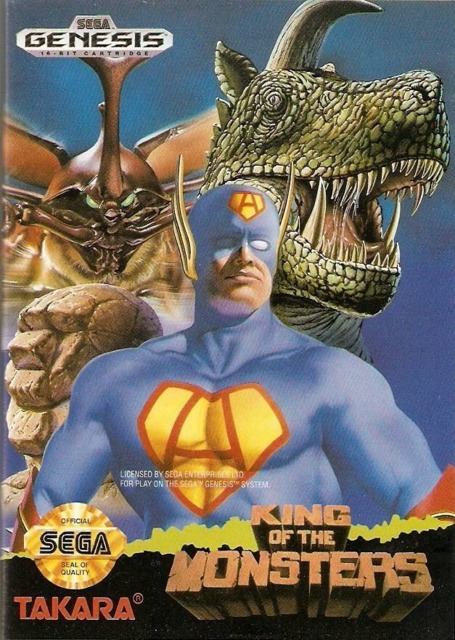
- Developer: SPS
- Publisher: Takara (NA) / Sega (EU/JP)
- JP Release: 1993-11-26
- NA Release: March 1993
- EU Release: 1993
- Franchise: King of the Monsters
- Genre: Arena Fighter
- Theme: Stomping on Japanese cities
- Premise: The kaiju are fighting again. Don't they have anything better to do?
- Availability: Best bet is the recent ACA Neo Geo rerelease available most on most systems. The Neo Geo version is better anyway.
- Preservation: We're back with another SNK port, this time for the mighty kaiju battler King of the Monsters. We'll be seeing its sequel on here before too long also. Goal of the game is to beat your opponent into submission, and if your atomic breath is insufficient you could always pick up an office building and club your rival over the head with it. Don't worry about the incalculable human casualties; it's not like Japan has a birth rate issue or anything. As with any Neo Geo to Mega Drive port, much of the content has been scrapped to fit on the smaller carts along with a hefty downgrade in image and sound quality. Cynically, I suspect this was done to funnel more players to the expensive SNK system once they saw comparison shots in the wild, which might be why SNK was happy to sign off on ports. Game development for the MD version was handled by SPS: we've met them just once before with the strategy game Ransei no Hasha (Part XIV) and this would be their last for the system. They were better known in Japan for their many Sharp X68000 games, including a few Sega ports.
- Wiki Notes: Barely had to touch a thing. SNK has a posse around these parts.
405: Outlander
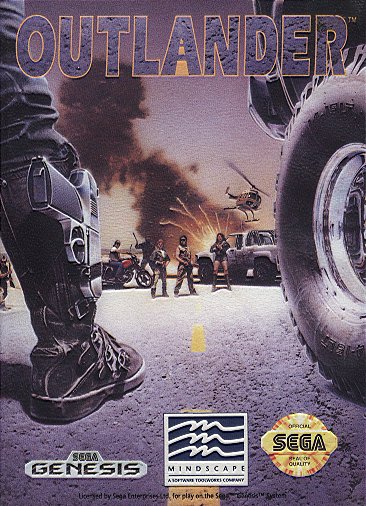
- Developer: Mindscape
- Publisher: Mindscape
- JP Release: N/A
- NA Release: March 1993
- EU Release: N/A
- Franchise: N/A
- Genre: Vehicular Combat
- Theme: Post-apocalypse
- Premise: Ever see Mad Max: The Road Warrior? Well, this isn't that. Nope. Nosiree. For real, though.
- Availability: Nope. I would just play that licensed Mad Max game from Avalanche instead.
- Preservation: Do we have a concept page for "this was a licensed game but the license vanished at some point during development"? Because this is a total case of that. Meant to tie-in with the 1981 George Miller joint about a hard-boiled survivor crossing an endless desert in a modified V8 Pursuit Special while evading colorful bandits and cannibals, the game instead had to switch tracks and present a new if still familiar narrative about "some guy" driving "some car" in the post-apocalypse. It doesn't follow the plot of the movie regardless, which had Max helping some settlers move their supply of gasoline west to LA, and just has the game's ersatz fighting off motorcycle creeps like a standard Road Rash type. The Mega Drive and SNES versions are functionally the same besides that the MD version insists on a cockpit view while driving. Doesn't seem like it rated well, if Wikipedia's one sourced "20%" score is any indication. This is also our first Mindscape developed game, though they've appeared a few times before as publishers. Mindscape primarily made computer games at this time—Captive, Moonstone, some early Warhammer stuff like Shadow of the Horned Rat—but had been growing in size after several acquisitions, allowing them to branch out into console game development. The following year they would buy Strategic Simulations Inc., the former custodians of the D&D license, and become one of the most prolific CRPG creators of the mid-'90s. They only developed one other MD game I'm aware of—NCAA Football—but we'll be seeing many more publishing credits from them yet, especially once we hit 1994.
- Wiki Notes: A SNES double dip, and the page had Genesis screenshots and releases from before I first worked on it. Total freebie.
406: Out of This World / Another World
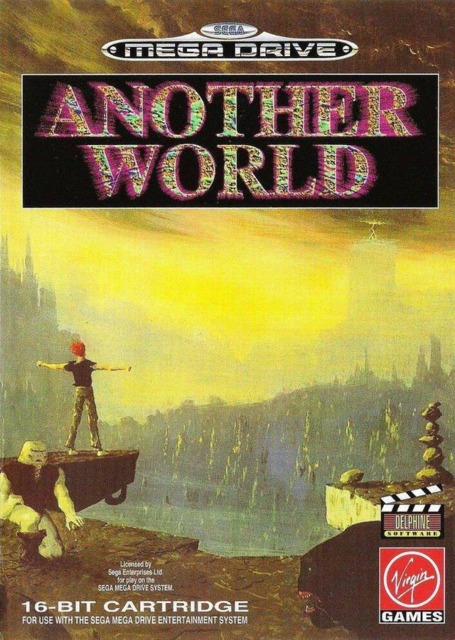
- Developer: Interplay
- Publisher: Virgin Interactive
- JP Release: N/A
- NA Release: March 1993
- EU Release: April 1993
- Franchise: N/A
- Genre: Action-Adventure / Platformer
- Theme: Sci-fi / Dying a lot
- Premise: Physicist Lester Knight Chaykin is teleported to an alien world after a freak accident at his lab and must survive in a hostile environment full of dangerous creatures both sapient and otherwise. He also meets a guy who says Mike Aruba a lot.
- Availability: The 20th Anniversary remaster is available if you wanted to grab it on Steam or GOG. Though we did just pass the game's 30th anniversary...
- Preservation: Eric Chahi's sci-fi cinematic epic comes to the Mega Drive mere weeks after its younger brother Flashback: The Quest for Identity (Part XXIX), and boasts a similar pedigree of rotoscoped animation and tense action-platforming sequences. It's a very trial-and-error game, to compensate for its svelte movie-length runtime, where you're likely to die to every obstacle once or twice until you've figured out the solution and can execute on it; not too dissimilar to early "cinematic" games like Dragon's Lair, though with a bit less abstraction. No pressing a direction to make a cutscene happen: you're doing all the shooting, jumping, and climbing yourself. More notable than this Mega Drive port, which is totally serviceable, is the Mega CD version that followed in 1994: it added a whole new campaign, Heart of the Alien, to take advantage of the CD-ROM tech. Chahi had no involvement with it though, as he was pretty adamant at the time that he didn't want to make any sequels so that its story could stand alone. This is also our first Interplay-developed game! Like Mindscape, just above, they were the biggest name in CRPGs around this time and would eventually publish Fallout and Baldur's Gate, ushering in that whole era. Why they're here porting Delphine games is anyone's guess, but someone had to I suppose. They published many more Genesis games, but only developed one more: Boogerman: A Pick and Flick Adventure. Look forward to my barely-concealed disgust when we cover that.
- Wiki Notes: Like Outlander, this page was practically complete the first time I visited for the SNES project. Just needed the MD EU box art image, the MD EU release, and a few screenshots.
407: Power Monger
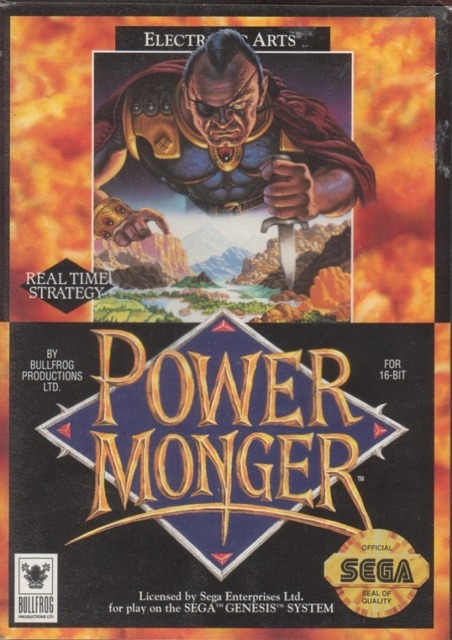
- Developer: Bullfrog / Sprytes
- Publisher: Electronic Arts
- JP Release: 1993-06-18
- NA Release: 1993
- EU Release: March 1993
- Franchise: N/A
- Genre: God-sim
- Theme: To crush your enemies, see them driven before you, and to hear the lamentation of their women.
- Premise: As a warlord, you are to lead your armies to victory with careful planning and aggressive tactics.
- Availability: Though a successor to Populous it's not as renowned, so it has yet to see any remasters or reboots. The original's not even on GOG.
- Preservation: Power Monger, or Powermonger (versions spell it differently), is Bullfrog's follow-up to their trailblazing god-sim Populous and boasts a considerably higher level of tech from the smart AI behind its many denizens to the 3D landscape overview. The player's role has been downgraded from land-shaping god to essentially a human overseer but you still have considerable free reign over your empire and its actions. The game also expands on the combat aspect, letting you train and equip troops and send them out to conquer neighboring lands. From what I recall playing as a kid it also has a lot of grisly imagery which I imagine was toned down for the console versions. What I did learn about researching the game this time (or maybe I forgot when I last researched it for the SNES wiki project) is that it had a WW1 expansion with more planned—including a Feudal Japan setting, so it might've been interesting to see how Japan would've received that—that never came to fruition. Despite being a superior successor in many ways, I guess the added complexity robbed it of some of Populous's accessible appeal. I've also no idea who Sprytes is: they're a UK developer but this port of Power Monger is the only game they're attached to and there's not much else about them out on the internet. Maybe they folded before they could put out any original games? A frequent hazard in this industry.
- Wiki Notes: Yet another SNES double-dip and a well-maintained page. Gotta say, this entry's been easy street so far.
408: Rolo to the Rescue / Zou! Zou! Zou! Rescue Daisakusen
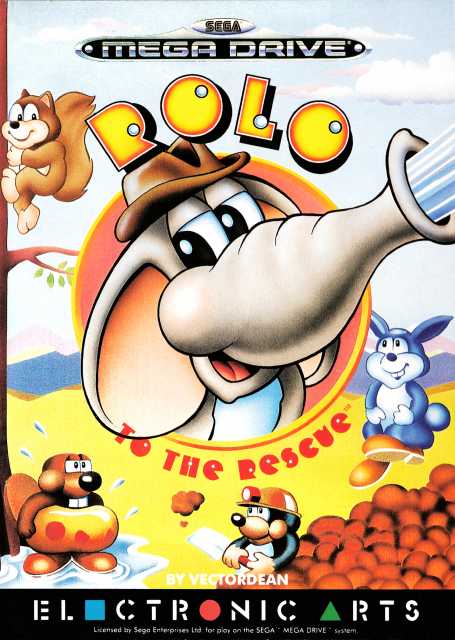
- Developer: Vectordean / Electronic Arts
- Publisher: Electronic Arts
- JP Release: 1993-04-29 (as Zou! Zou! Zou! Rescue Daisakusen)
- NA Release: March 1993
- EU Release: March 1993
- Franchise: N/A
- Genre: Platformer
- Theme: You know that song they play at baseball games? Baby Elephant Walk? It's like a visual representation of that. (You know that won a Grammy? What wouldn't, I guess.)
- Premise: Rolo the Elephant has to rescue his animal friends across a series of platforming stages, employing their talents to earn bonuses and reach the level's end.
- Availability: Nada. Yet to be put on EA Play for some reason.
- Preservation: Ah, the classic Amiga platformer. Too garish by half and super rudimentary compared to everything else available at the time. (Though, much like James Bond 007: The Duel, it was developed specifically for the Mega Drive; so it's more that it has an Amiga platformer sensibility.) Fans of this site should be well-acquainted with this innocuous platformer full of cute animals: it's been featured at least twice, most recently on the Evil Uno show Ranking of Evil. As our wiki page points out, the game has sixty stages and no means of saving progress, so it's definitely an endurance playthrough in more ways than one. Vectordean was behind it, and if you couldn't tell from their bulbous character designs you probably could with the crazy momentum it has on slopes that they're the James Pond guys. I don't think they branched out beyond James Pond again after this, though reviews at the time were fairly glowing.
- Wiki Notes: Beefed up the main body and added some releases and screenshots. Also added that Japanese name as an alias, because it's a keeper. Who wouldn't want to buy a game called "Elephant! Elephant! Elephant!"? You know exactly what you're getting. Elephant.
409: Strider Returns / Strider II
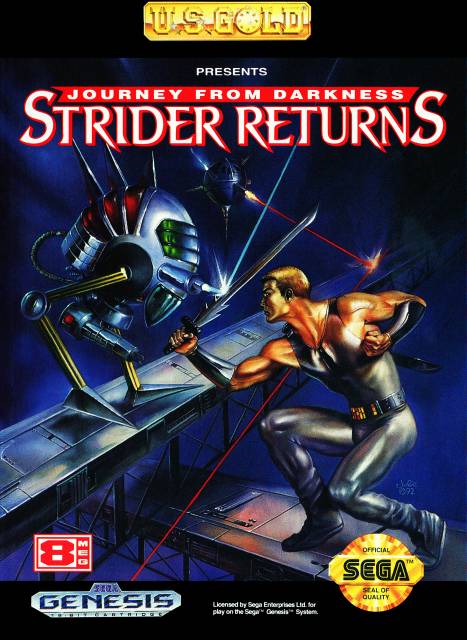
- Developer: Tiertex
- Publisher: US Gold
- JP Release: N/A
- NA Release: August 1993
- EU Release: March 1993
- Franchise: Strider
- Genre: Action-Platformer
- Theme: Striding, but much more slowly this time.
- Premise: Strider Hinjo is back after defeating the Grandmaster, now launching off into space to save a hot alien queen from, uh, the Grandmaster again. What? No, he's always been called Hinjo.
- Availability: Nope. I don't think Capcom will be adding it to any fancy Strider compilations either, if that's what they're planning once they finally run out of Mega Man games.
- Preservation: We're continuing a mini-theme this entry of disappointing games from British companies, stretching their Amiga game development muscles for the sake of the Mega Drive's popularity in Europe. Of course, this is one case where I feel like we bamboozled the rest of the world, introducing a sequel-in-name-only to one of Sega Genesis's most renowned action-platformers: Capcom's Strider (Part IV), an arcade game with an alacrity that made it a perfect complement to the Mega Drive's vaunted "blast processing". I'm not going to make excuses here, except to say that Strider did well on home computers in Europe too and it was natural for the regional license holders and port developers to work on their own sequel to meet the high demand. Strider II, or Strider Returns, isn't really a patch on the original with its awkward and sluggish controls taking much away from the fluidity of the original. Folks 'round here might know this as Strider, but less so in other parts of the world as Capcom was happy to write it off as non-canonical and make their own Strider II years later for PlayStation. Happily, elsewhere, two different UK developers (Rare and Argonaut) were getting along swimmingly with Japan and putting out some of the most impressive games on the SNES so... yeah. While I'd like to think of this as an aberration as an Atari ST owner I'd have to admit games like Strider Returns were probably the rule more than the exception. (Incidentally, we last saw the Tiertex and US Gold combo with Indiana Jones and the Last Crusade (Part XXIII). Of Tiertex's five remaining MD games we've yet to cover, four are sports-related. Hooray.)
- Wiki Notes: Really not sure what GameFAQs is playing at, suggesting this came out on Genesis in 1990. The first Strider was released on the system in late 1990 (following the arcade debut the previous year) so it makes little to zero sense that its sequel somehow preceded it. Sega Retro has the date I used here (with citations) so that's what I'm opting for. As for the page, it needed some work: kinda figured we had enough Strider fans around who would've maintained it better, but then I guess most Strider fans would prefer to ignore it exists.
410: Tiny Toon Adventures: Buster's Hidden Treasure
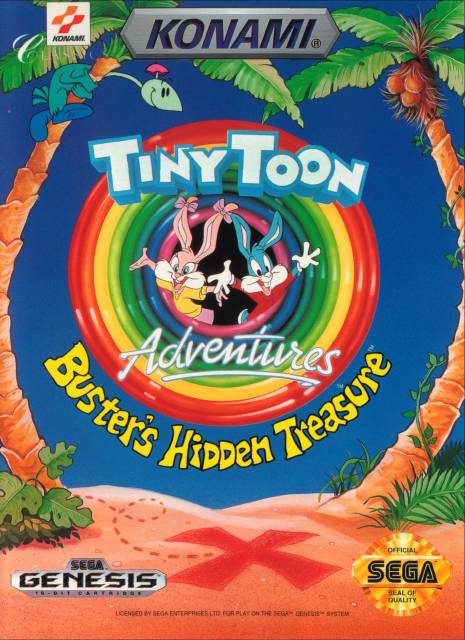
- Developer: Konami
- Publisher: Konami
- JP Release: N/A
- NA Release: March 1993
- EU Release: June 1993
- Franchise: Tiny Toons Adventures
- Genre: Platformer
- Theme: We're all a little loony if you think about it. Hi, I'm the Joker now.
- Premise: Buster Bunny finds a treasure map but Montana Max is quick to steal it, employing a henchperson to kidnap and hypnotize Buster's friends to slow him down as they both chase after the hoard's location.
- Availability: Nope. Of their many 16-bit classics Konami could be re-releasing, the licensed ones are probably last in line.
- Preservation: A lot of animation franchises got hit hard by bad licensed games, especially those associated with Warner Bros.' Looney Tunes stable, but thanks to Konami Tiny Toons felt like one of the few that made out just peachy with a series of games that, even at their worst, were only kind of tough. These games very rarely plumbed the parodic waters that the show made its bread and butter, preceding the likes of Animaniacs and Freakazoid to follow, instead presenting colorful cartoon adventures full of speedy platforming that usually did right by the show's manic energy at least. I can't find much evidence to support this, but coming out around the same time as the SNES's Buster Busts Loose suggests the two games were system analogues, though not identical. Like most Konami games of the era it both looks great and plays great, though was maybe a little too generic to leave much of an impression. (We last saw Konami with Teenage Mutant Ninja Turtles: The Hyperstone Heist (Part XXVI), which was also a Mega Drive exclusive that nicely complemented its SNES counterpart. Ditto for their upcoming Castlevania: Bloodlines and Contra: Hard Corps.)
- Wiki Notes: Heavy edits to all areas. As always, appreciate any prior work these pages receive especially when we hadn't nailed down a style guide yet (still haven't, really) and folks were unsure of what to do.
Log in to comment